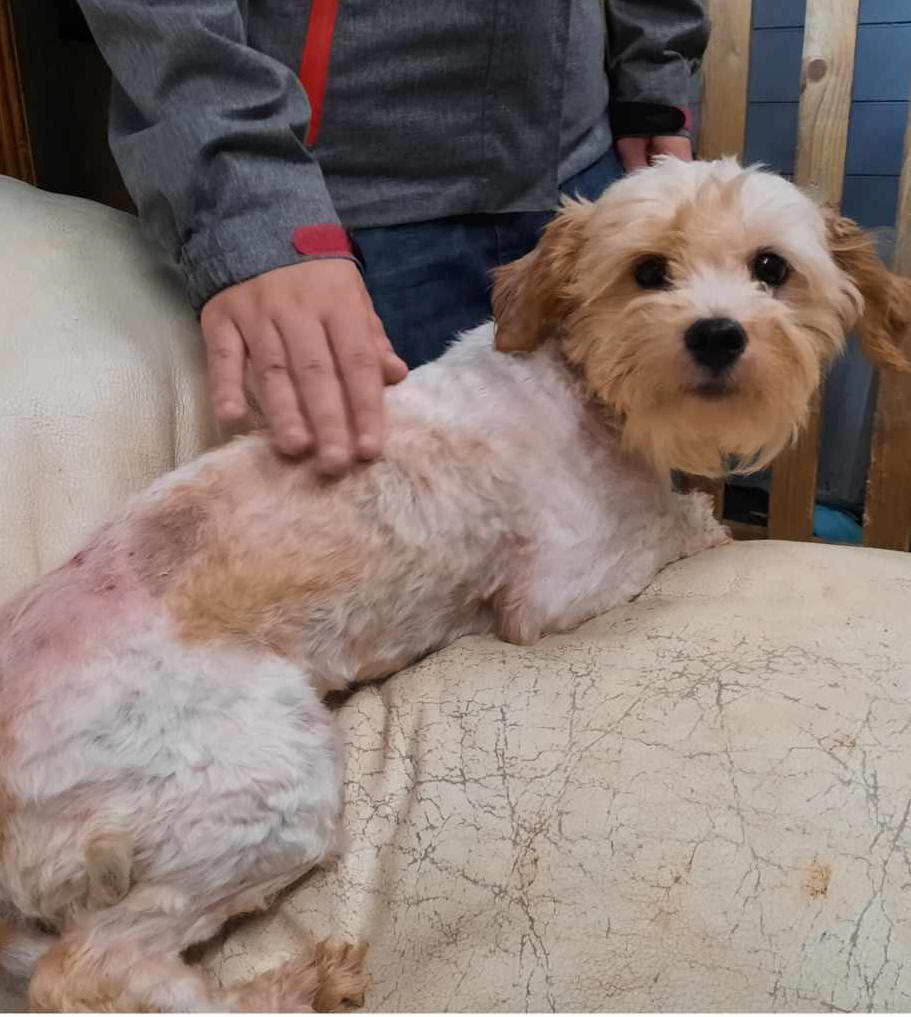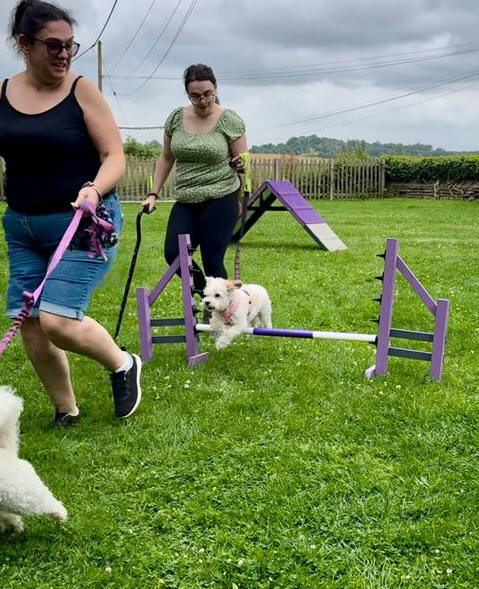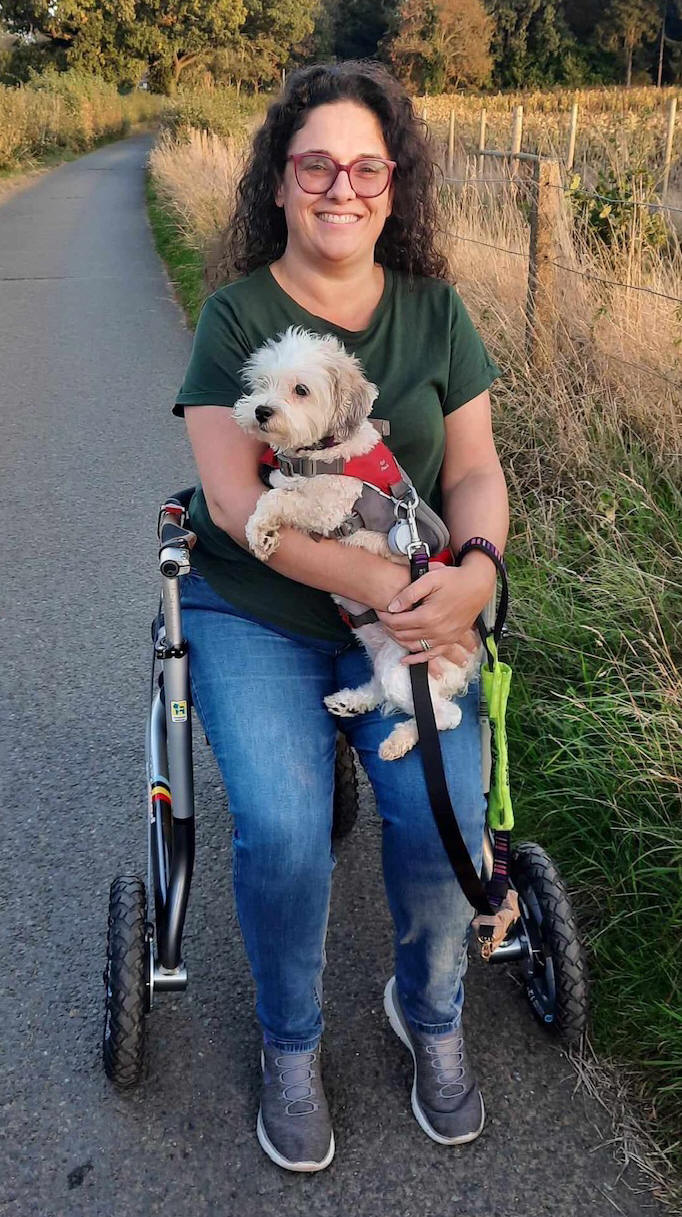How agility helped
an agoraphobic dog...
 Imogen
Edwards had always wanted a dog. Due to her disability, she was looking for a
small one that wouldn't need much exercise and one that did not shed as she is
allergic to a lot of breeds. Then she saw a group of dogs rescued from Romania
on the Little Rescue Facebook group. When Imogen first met Daisy, she was
pressed flat against the wall, but she had a pretty face, so Imogen scooped her
up and they just sat together for ages. That's when Imogen knew that Daisy was
the dog for her. What she didn't know was that Daisy was afraid to go outside. Imogen
Edwards had always wanted a dog. Due to her disability, she was looking for a
small one that wouldn't need much exercise and one that did not shed as she is
allergic to a lot of breeds. Then she saw a group of dogs rescued from Romania
on the Little Rescue Facebook group. When Imogen first met Daisy, she was
pressed flat against the wall, but she had a pretty face, so Imogen scooped her
up and they just sat together for ages. That's when Imogen knew that Daisy was
the dog for her. What she didn't know was that Daisy was afraid to go outside.
Daisy was one of 11
scruffy dogs rescued from a puppy farm in Romania when she was around two years
old. She was in an awful condition. We think she was kept permanently inside a
barn and used as a breeding bitch. We did a DNA test on her and found out she's
a combination of 14 breeds, 50% of which is Pekinese and Poodle. Guess they were
trying to breed cute fluffy dogs!
It took a while for
Daisy to get used to everyday things like the TV. At first, she would cautiously
go into our garden, but walks were always too overwhelming. Within a few months
of her arrival, we got new neighbours with a noisy toddler. The sound of their
voices terrified her, and she stopped going in the garden. She spent most of her
time hiding away in corners or in her bed upstairs until 9pm when she would
appear for food. For two years, Daisy didn't make a sound.
She was a really
traumatised dog. She hated being outside in daylight and was particularly scared
of children. Our vet said she was the most nervous dog she had ever met and
referred us to a specialist behavioural vet who diagnosed Daisy with PTSD and
noise phobia. Consequentially, she is on a combination of three anxiety meds.
 To
further complicate matters, a year ago, Daisy was, at just four years old,
diagnosed with cataracts in one eye. She has daily eye drops which help to
maintain her condition, but having sight in only one eye probably has
contributed to her fears. To
further complicate matters, a year ago, Daisy was, at just four years old,
diagnosed with cataracts in one eye. She has daily eye drops which help to
maintain her condition, but having sight in only one eye probably has
contributed to her fears.
Enter Charlie
Though we worked really hard to socialise her, Daisy
continued to hide all day until it was dark. She wouldn't take treats and
regularly needed spoon feeding which involved me lying on the floor under the
table.
After two years, we
decided that another dog might help her. We looked on the internet and found
Charlie, a Bichon X from Bosnia. He'd had a very different experience from
Daisy. Bought from a breeder, he was kept as a family pet until they got bored
with him and put him out onto the street.
Charlie was the perfect
friend for Daisy, a friendly, happy dog that showed her how to play and stopped
her from peeing in the house. With his introduction, she found her voice. She
now loves to yap at him. If he asks to go outside, she rushes over in a
disapproving manner. It was a big improvement, but still she rarely left the
house.
 Dog
training with Neil Dog
training with Neil
Three years after we got
Daisy, Charlie and I started doing classes with a local dog trainer,
Neil from HT Dog Training. Sometimes Daisy would come along with us, sitting in
the car with the door open.
Several weeks ago, Neil
agreed to start working with Daisy. He taught us some new games to encourage her
to engage with us and come out of her shell, and he introduced us to the magic
of liver paste which helped us coax Daisy out to find treats and get closer to
the back door during daylight.
Within a few short
weeks, we got Daisy coming out to spend time with us from 2pm, looking to play
games like touch and find it. She jumps up on the sofa to sit and have her liver
paste reward. With Neil, we have been getting her used to noises like children
playing and balls bouncing by playing pre-recorded sounds on YouTube while being
safe at home. I didn't know such things existed.
After Charlie started
fun agility, it was Neil who encouraged me to bring Daisy along. We were both
amazed when she sniffed around the other dogs and the equipment. When it was
Charlie's turn, she just happily followed him round the course. After that every
time he went round, she did, too. It was incredible to see that the more we went
around the course, the more interest she paid to the equipment. Neil had
stressed the importance of distracting Daisy while she was outside to reduce her
anxiety. Well, the agility really did that.
I asked Neil to add
his comments from his prospective and this is what he said. 'Working with
Daisy and her family has been an absolute joy. As a nervous and anxious dog,
it was important to work at Daisy's pace, using lots of positive
reinforcement while we built her confidence. I tried to focus on giving her
family the tools they needed to help her in different situations. I won't
lie. My heart melted the day she joined in the agility socials. See how
proud her family was really is why I became a trainer.'
We are definitely going
to continue with agility. Neil runs fortnightly 'social agility' sessions. and
Daisy is booked in for the next session.
Continuity is important for her.
I am glad to say that
Daisy now comes out of the house at least three to four times a week and is
engaging in walks with Charlie. My heart is melting, tooI
 About
the author... About
the author...
Imogen Edwards always wanted
to get a dog. Once her kids had grown up, she decided it was the right time. She
found Daisy on The Little Rescue Facebook group for three years ago. Little did
she know what she was getting into.
She works at home and
makes disabled blue badge covers in 80 different fabrics as well as parking
permit holders, travel passes and passport holders.
Imogen lives in
Hertfordshire.
First published
3rd August 2024
|